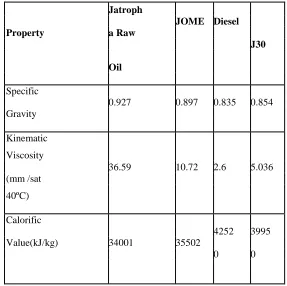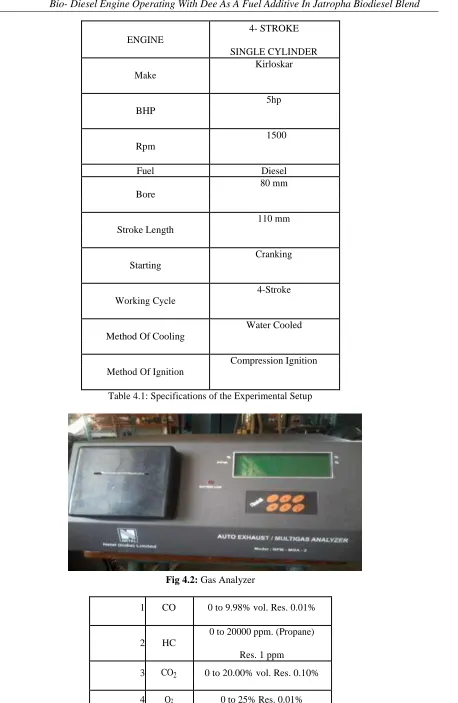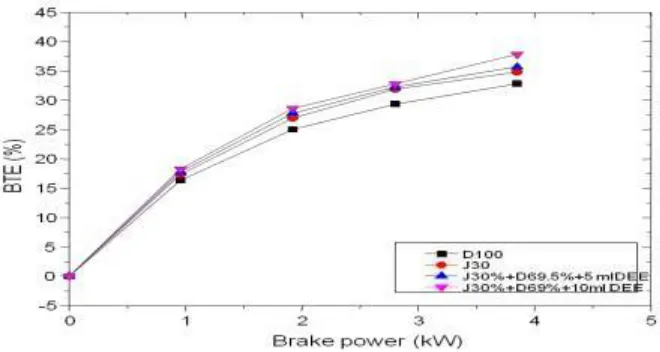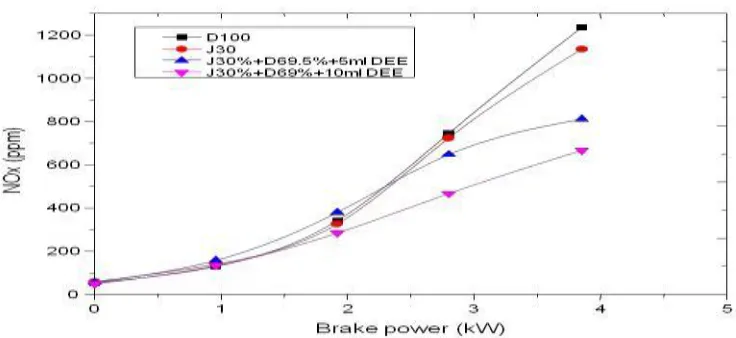IOSR Journal of Engineering (IOSRJEN)
www.iosrjen.org
ISSN (e): 2250-3021, ISSN (p): 2278-8719
Vol. 07, Issue 10 (October. 2017), ||V1|| PP 61-68
Performance Of Diesel Engine Using Jatropha Bio-Diesel Blend
With Ignition Improver
N.Satyanarayana
1
,
Dr. B R Bundel
2
,
Dr.Y.V. Hanumantha Rao
3
1Scholar, Department of Mechanical Engineering, Lingaya’s University, Faridabad New Delhi, India
2Associate Professor & Head Department of Mechanical Engineering Lingaya’s University
3
Professor, Department of Mechanical Engineering, K.L. University, Greenfields, Guntur (D.t), A.P, India
Abstract
:
Exceptional resembling the all around requested utilization of world oil spares, rise the jatropha oil cost and results for normal defilement of extending vapor outpouring there is a desperate prerequisite for sensible alternate fuel for diesel engines. The present examination covers the stage I, these tests are driven on a four stroke single barrel water cooled organize implantation diesel engine with reliable speed by using diesel and basic data is made through fluctuating weights. In second stage, test examination has been done on a comparable engine with same working parameters by using the Jatropha oil methyl esters blend with a degree J30 by extension of Die Ethyl Ether with Ignition improver of 5ml, 10ml to find the output and discharge parameters. The fundamental motivation behind start improver is to enhance the burning procedure and lessen the discharges. The version and discharge parameters got in the above tests were thought about in line fundamental diesel information.The blend J30 with begin improver 10 ml exhibits diminished releases like CO, HC, NOX, smoke thickness and upgraded adequacy like brake warm profitability, BSFC.Keywords –Biodiesel, Emissions, Performance, Jatropha oil Methyl Ester Blends, Die Ethyl Ether --- ---
Date of Submission: 13-10-2017 Date of acceptance: 23-10-2017 --- ---
I. INTRODUCTION
Utilization of the petroleum products increments universally step by step, to satisfy the vitality prerequisite of the world, there is a need to discover an option determination. In the fields of transportation, modern advancement and farming, oil powers assume an indispensable part. Petroleum derivatives are fast exhausting a direct result of augmentation in fuel utilization. To substitute the diesel fuel with a fitting option fuel, for example, biodiesel many research works are going on. Extraordinary compared to other accessible sources to satisfy the vitality prerequisite of the world is Biodiesel. Non-consumable sources, for example, cotton seed Oil, Jatropha Oil, Mahua Oil, Jatropha Oil, and Karanja Oil have been investigated for biodiesel fuel generation. In the current circumstances, numerous scientists have put a few endeavors to utilize different wellsprings of vitality as nourish in existing diesel motors. Numerous specialists have watched that biodiesel mix gives more prominent warm productivity and emanation parameters. Among the distinctive procedures open to diminish fumes emanations from the diesel motor while utilizing biodiesel, the utilization of start improvers is directly engaged as a result of the upside of an upgrade in fuel effectiveness while decreasing unsafe fumes discharges
II. BIODIESEL PRODUCTION &BLENDS
Trans-esterification of jatropha oil is made out of warming of oil, expansion of KOH and methyl liquor, blending of blend, partition of glycerol, washing with refined water and warming for evacuation of water. The biodiesel (JOME) so delivered was blended with diesel in changing extents like D100, J30, J30+D69.5+DEE5ml with the assistance of an attractive stirrer. The principle motivation behind the DEE is to enhance start and warm proficiency alongside diminishment in emanation parameters
Table: 2.1 Preparations of Blends
Blend Dies Biodies Improver( El el (%) ml) (%)
D100 100 -
-J30 70.2 30
-J30+D69.5+DEE 69.67 30 5
5ml
J30+D69+DEE1 69.2 30 10
III. PROPERTIES OF FUEL
The important properties of Jatropha raw oil, JOME, J30 are compared with the diesel were shown in the Table 3.1.
Jatroph
JOME Diesel
Property a Raw
J30
Oil
Specific
0.927 0.897 0.835 0.854 Gravity
Kinematic
Viscosity
36.59 10.72 2.6 5.036 (mm /sat
40ºC)
Calorific
4252 3995
Value(kJ/kg) 34001 35502
0 0
Table 3.1 Properties of Raw Jatropha Oil in Comparison With Diesel
IV. EXPERIMENTAL SETUP
The game plan comprising of a 4-stroke diesel single barrel motor alongside mechanical brake drum is settled to the motor fly wheel. A different board load up is utilized to settle burette with stop clock execution examination is, to top off the recognized diesel fuel mix into the fuel tank mounted on the board outline. the motor is begun and enabled it to balance out at 1500rpm. Presently stack the motor in venture of quarter, half, three fourth and full loads and enable the motor to balance out at each heap. (Note all the required parameters showed on the computerized markers which are mounted on the board like, speed of the motor from advanced rpm pointer, stack from the spring balance, fuel utilization from burette, amount of wind stream from manometer. Likewise, fumes gas is sent into fumes gas analyzer. for the examination of discharge display specific diesel fuel mix. Sct-g-5 multi gas analyzer (5 gasses) depends on infrared spectrometry innovation with flag contributions from an electrochemical cell.
Fig 4.1: Experimental Setup
Bio- Diesel Engine Operating With Dee As A Fuel Additive In Jatropha Biodiesel Blend
4- STROKE ENGINE
SINGLE CYLINDER Kirloskar Make
5hp BHP
1500 Rpm
Fuel Diesel
80 mm Bore
110 mm Stroke Length
Cranking Starting
4-Stroke Working Cycle
Water Cooled Method Of Cooling
Compression Ignition Method Of Ignition
Table 4.1: Specifications of the Experimental Setup
\
Fig 4.2: Gas Analyzer
1 CO 0 to 9.98% vol. Res. 0.01%
0 to 20000 ppm. (Propane) 2 HC
Res. 1 ppm
0.200 to 1.800% Res. 5 Lambda
0.001% Air /
6 0 to 30:1 Res.1
Fuel
Table 4.2: Specifications of the gas analyzer
V. RESULTS AND FINDINGS
The experiments performed on a 4-stroke Diesel Single cylinder water cooled engine at constant speed 1500 rpm with blends by adding ignition improver and varying loads. Various performance parameters such as brake specific fuel consumption, brake thermal efficiency and various emission parameters in the sense of smoke density, unburned hydrocarbons, carbon monoxide and oxides of nitrogen are discussed below.
5.1 Brake Thermal Efficiency
The progressions of brake warm effectiveness with brake control is appeared in Fig. 5.1 from the chart it is watched that as the Brake Power increments there is significant increment in the BTE. The BTE of diesel at full load is 32.82% while the mixes of J30 is 34.79%, J30+D69.5+DEE5ml is 35.69 %, J30 + D69 + DEE10ml is 37.80%, among the three the most extreme BTE is 37.80% which is acquired for J30+D69+DEE10ml. The BTE of JOME is increments up to 5.91 % as contrasted and ideal mix at full load condition. The change in effectiveness of brake warm parameter is principally because of better burning because of adding start improver it impacts to diminish the thickness of JOME.
Fig.5.1 Variation of Brake thermal efficiency with brake power
5.2 Brake Specific Fuel Consumption
Bio- Diesel Engine Operating With Dee As A Fuel Additive In Jatropha Biodiesel Blend
Fig.5.2 Variation of BSFC with brake power
5.3 Smoke Density
The variation of smoke density with brake power is shown in Fig. 5.3. The plot it is observed that the smoke is nothing but solid soot particles suspended in exhaust gas. The variation of smoke level with brake power at various loads for different blends like J30, J30+D69.5+DEE5ml, and J30+D69+DEE10ml tested fuels. At full load condition the smoke density obtained are 79.6 HSU, 53.26HSU, 89.49 HSU and 87.89 HSU for the fuels of diesel, J30, J30+D69.5+DEE5ml and J30+D69+DEE10ml.It is observed that smoke is lower for optimum blend at full load conditions compared to ignition improver blends. It is due to heavier molecular structure and atomization becomes poor and this leads to higher smoke emission in the scene of adding ignition improver.
Fig.5.3 Variation of Smoke density with brake power
5.4 Carbon Monoxide Emission
Fig.5.4 Variation of Carbon monoxide with brake power
5.5 Unburned Hydrocarbon Emission
The variation of HC emission with brake power is shown in Fig. 5.5. The plot it is observed that the HC emission variation for different blends is indicated. At full load condition the unburned hydrocarbons are obtained 58ppm, 53ppm, 21ppm and 17ppm for the fuels of diesel, J30, J30+D69.5+DEE5ml and J30+D69+DEE10ml respectively That the HC emission decreases with increase in load and it is almost decreases for adding ignition improver blends where some traces are seen at no load and full load. The reason behind due to charge homogeneity and higher oxygen availability, the unburned hydrocarbon level is less in the case of JOME.
Fig.5.5 Variation of unburned hydrocarbons with brake power
5.6 Oxides of Nitrogen Emission
Bio- Diesel Engine Operating With Dee As A Fuel Additive In Jatropha Biodiesel Blend
Fig 5.6 Variation of NOXwith brake power
The maximum brake thermal efficiency for blended fuels with added ignition improver J30+D69+DEE10ml (37.80%) was higher than that of J30 and diesel. The brake thermal efficiency increased in 8.65%, 15.17% compared with J30 and diesel. Brake specific fuel consumption is decreases in blended fuels with added ignition improver. In J30+D69+DEE10ml fuel the BSFC is lower than the J30 and diesel .The decreased in BSFC in 5.01% and 7.54%. Significant reductions were obtained in unburned hydrocarbons emissions with J30+D69+DEE10ml blend compared with J30 and diesel. Unburned hydrocarbons were decreased by 67.92%, 70.68% compared to J30 and diesel at maximum load of the engine.
VI. CONCLUSION
The investigations are carried out on the same engine with addition of diethyl ether (DEE) (ignition improver) 0.5ml, 10ml to blend J30, J30+D69.5+DEE5ml, J30+D69+DEE10ml gives out performance and emissions parameters and compared with optimum blend and diesel base line data. Out of this 10ml volume addition of ignition improver (J30+D69+DEE10ml) shows best results in performance and emissions parameters.
REFERENCES
[1] M. Gumus .‖Evaluation of hazelnut kernel oil of Turkish origin as alternative fuel in diesel engines‖. Renewable Energy 33 (2008) 2448–2457 Cengiz Oner a, S_ehmus Altun. ―Biodiesel production from inedible animal tallow and an experimental investigation of its use as alternative fuel in a direct injection diesel engine‖.
[2] M. Mani, C. Subash , G. Nagarajan.―Performance, emission and combustion characteristics of a DI diesel engine using waste plastic oil‖ Applied Thermal Engineering 29(2009) 2738–2744
[3] T. Venkateswara Rao , G. Prabhakar Rao and K. Hema Chandra Reddy. ―Experimental Investigation of Jatropha, Jatropha and Neem Volume 2,Number 2 (ISSN 1995-6665)
[4] Jayant Singh, T. N. Mishra, T. K.Bhattacharya, and M. P. Singh. ―Emission Characteristics of Methyl Ester of Rice Bran Oil as Fuel in Compression Ignition Engine‖. World Academy of Science, Engineering and Technology, vol no: 36 2007
[5] M. Gumus .‖Evaluation of hazelnut kernel oil of Turkish origin as alternative fuel in diesel engines‖. Renewable Energy 33 (2008) 2448–2457 Cengiz Oner a, S_ehmus Altun. ―Biodiesel production from inedible animal tallow and an experimental investigation of its use as alternative fuel in a direct injection diesel engine‖.
[6] Jagannath Balasaheb Hirkude a, Atul S. Padalkar ―Performance and emission analysis of a compression ignition Engine operated on waste fried oil methyl esters‖. Applied Energy ,vol no:90 (2012) 68–72 [7] Arjun B. Chhetri 1, Martin S. Tango 1,2, Suzanne M. Budge 1, K. Chris Watts 1 and M. Rafiqul Islam
1,* Non-Edible Plant Oils as New Sources for Biodiesel Production Int. J. Mol. Sci. 2008, 9(2), 169-180; doi:10.3390/ijms9020169
[9] Miura K, Ikeda M, Matsubara A, Song XJ, Ito M, Asano K, Matsuoka M, Kitano H, Ashikari M: OsSPL14 promotes panicle branching and higher grain productivity in rice. Nat Genet
2010,42(6):545-549. 10.1038/ng.592View ArticleGoogle Scholar
[10] Song XJ, Huang W, Shi M, Zhu MZ, Lin HX: A QTL for rice grain width and weight encodes a previously unknown RING-type E3 ubiquitin ligase. Nat Genet 2007,39(5):623-630.
10.1038/ng2014View ArticleGoogle Scholar
[11] Xing Y, Zhang Q: Genetic and molecular bases of rice yield. Annu Rev Plant Biol 2010, 61: 421-442. 10.1146/annurev-arplant-042809-112209View ArticleGoogle Scholar
[12] Hua J, Xing Y, Xu C, Sun X, Yu S, Zhang Q: Genetic dissection of an elite rice hybrid revealed that heterozygotes are not always advantageous for performance. Genetics 2002,162(4):1885-1895.Google Scholar
[13] Yan WH, Wang P, Chen HX, Zhou HJ, Li QP, Wang CR, Ding ZH, Zhang YS, Yu SB, Xing YZ: A major QTL, Ghd8, plays pleiotropic roles in regulating grain productivity, plant height, and heading date in rice. Mol Plant 2011,4(2):319-330. 10.1093/mp/ssq070View ArticleGoogle Scholar



